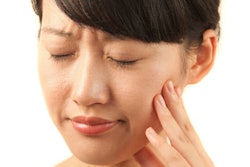
What's the best way to manage pain in patients with temporomandibular disorder (TMD)? Authors of a recent review propose a conservative approach that includes multiple kinds of treatments, including dental, psychological, medical, and physical therapies.
Researchers examined studies on the effectiveness of various treatments for patients with craniofacial pain and TMD. Based on their findings, they developed a model that incorporates conservative multidisciplinary treatment.
"A conservative approach appears to be the best option for the management of chronic painful TMD. The treatment methods included in this model are structured to achieve reduction in pain perception, improvement of motor behavior, and improvement of cognitive and emotional factors related to pain," wrote the authors, led by Alfonso Gil Martinez, PhD, a physical therapist at Autonomous University of Madrid in Spain (Journal of Pain Research, March 16, 2018).
Taming the pain
Dentition, clenching, and other factors contribute to TMD's complexity and symptoms of muscular, articular, and periarticular pain, the authors noted. This disorder is also associated with depression and other psychological factors, as well as the loss of work productivity.
Temporomandibular disorder is caused by functional, structural, and psychological factors, they wrote. However, pain is the primary problem and typical reason patients seek care. This pain can affect a patient's ears, eyes, and throat and also produce headaches. Inflammatory problems such as secondary synovitis, infection, and irritation and also disk dysfunction can occur.
For their review, the researchers sought to evaluate recent evidence, identify challenges, and propose clinical solutions for patients with craniofacial pain and TMD.
Previous research indicates that management should focus on alleviating the main signs and symptoms, such as the presence of joint sounds (clicking and crepitation), reduced mouth opening, and disrupted jaw movements, the authors wrote.
Treatments that include physical, psychological, and pharmacological therapies are now receiving clinical support and scientific focus, they explained. A conservative treatment approach is favored since it is less aggressive and usually yields reasonable clinical outcomes for mild to moderate TMD.
Accordingly, the authors provided evidence from meta-analyses for various types of TMD treatments. They reported a lack of evidence to support surgical interventions, with three meta-analyses indicating that internal derangements of the temporomandibular joint (TMJ) are better managed nonsurgically.
They also noted insufficient evidence to recommend orthodontic intervention or occlusal adjustment to treat TMD. However, splint therapy is among the most commonly mentioned conservative treatments for TMD pain associated with bruxism and for internal derangements, according to their research.
Nonetheless, it remains unclear whether stabilization splints actually reduce pain, although they appear to have a placebo effect for pain management. One meta-analysis found them effective in patients with myogenic TMD to prevent dental damage in those with bruxism.
Various medications proven effective for other musculoskeletal conditions are typically prescribed for TMD, with some used to treat joint pain and others muscle pain. The most commonly used include nonsteroidal anti-inflammatory drugs, corticoids, analgesics, muscle relaxants, anxiolytics, opiates, tricyclic antidepressants, gabapentin, and lidocaine patches.
| Evidence for pharmacotherapy for TMD-related pain | |||
| Treatment/intervention | Oral and topical pharmacotherapy | Infiltrated pharmacotherapy | |
| Type of TMD | Arthrogenic | Myogenic | Arthrogenic |
| Evidence | 1 meta-analysis, 2 randomized controlled trials | 1 meta-analysis, 1 randomized controlled trial, 1 controlled trial | 1 meta-analysis |
| Magnitude of effects | Joint pain reduction with oral sodium diclofenac, naproxen sodium, and topical diclofenac | Muscle pain reduction with diazepam, cyclobenzaprine for local spasm and acute muscle pain, sodium diclofenac with coadjuvants (acetaminophen, carisoprodol, caffeine) for muscle pain, amitriptyline and nortriptyline for masticatory myofascial chronic pain | Injection with corticosteroid betamethasone and hyaluronate for joint pain |
The researchers reported varying levels of effectiveness for treating the pain, inflammation, and motor function affected by TMD with physical therapies, which include manual therapy (such as joint mobilization/manipulations and soft-tissue mobilization), therapeutic exercise, electrotherapy (such as low-level laser therapy, transcutaneous electrical nerve stimulation, therapeutic ultrasound, and shortwave), dry needling, and acupuncture.
They also provided evidence, particularly as complementary treatments, for the psychologically oriented approaches of cognitive-behavioral therapy, education and self-management, and relaxation techniques to reduce pain or disability.
Multimodal proposal
The review authors proposed multimodal treatment based on a biobehavioral model of pain perception and motor behavior. It acknowledges the importance of psychological factors, such as pain history, current emotional and cognitive status, and coping skills, and patients learning to self-manage pain and improve function.
Their model also includes motor and sensory factors, such as range of movement, level of physical activity, endurance and strength, motor control, and extent and location of pain.
"A fundamental aspect of our model is the fact that musculoskeletal pain produces changes in motor behavior," the authors wrote.
To reduce pain intensity, they proposed the use of manual therapy, dry needling, and pharmacology.
"For improvements in pain and mandibular function, it is relevant to apply a combined intervention of manual therapy and therapeutic exercise directed to the orofacial, craniomandibular, and upper cervical regions," they wrote.
They noted that their TMD management recommendations are most applicable for cases with mild to moderate chronic pain, while those with acute or subacute pain may be handled effectively with less complex unimodal or bimodal approaches.
"The main variable to achieve optimum functional recovery is disability: We propose that if we improve the motor behavior, we will decrease the disability and in turn the painful perception," the authors concluded.



















